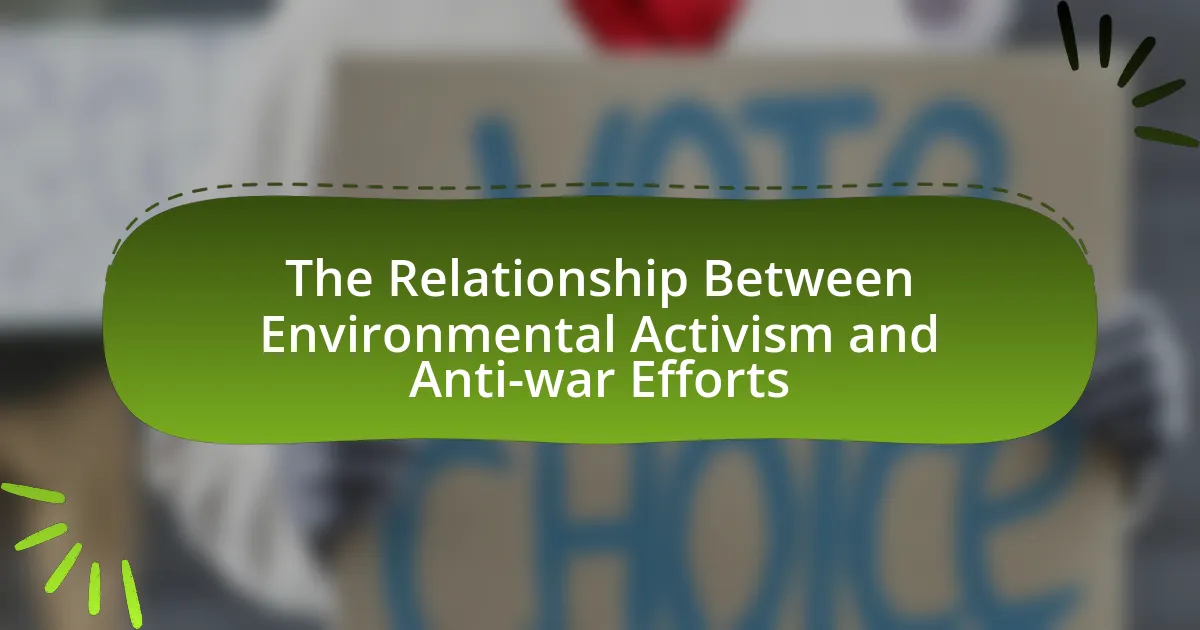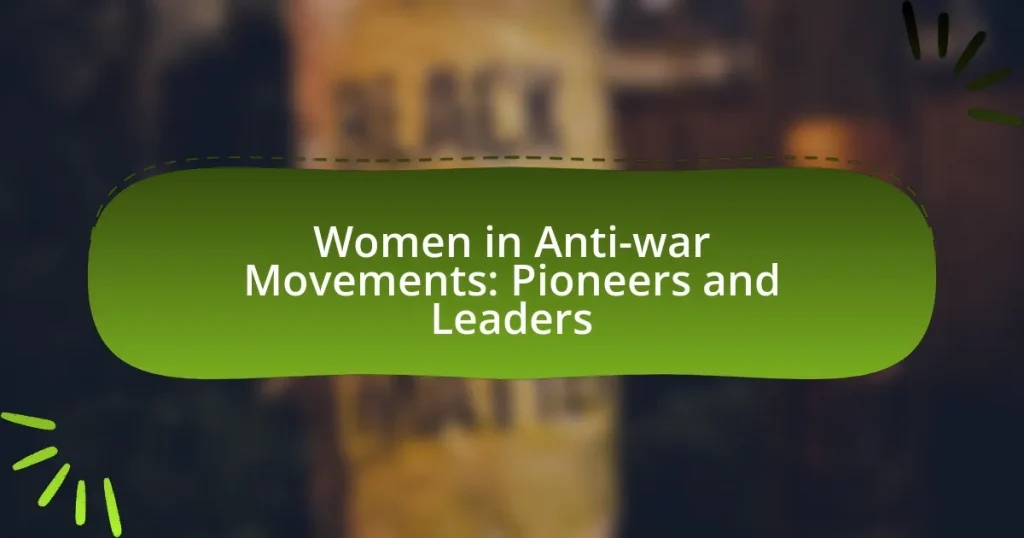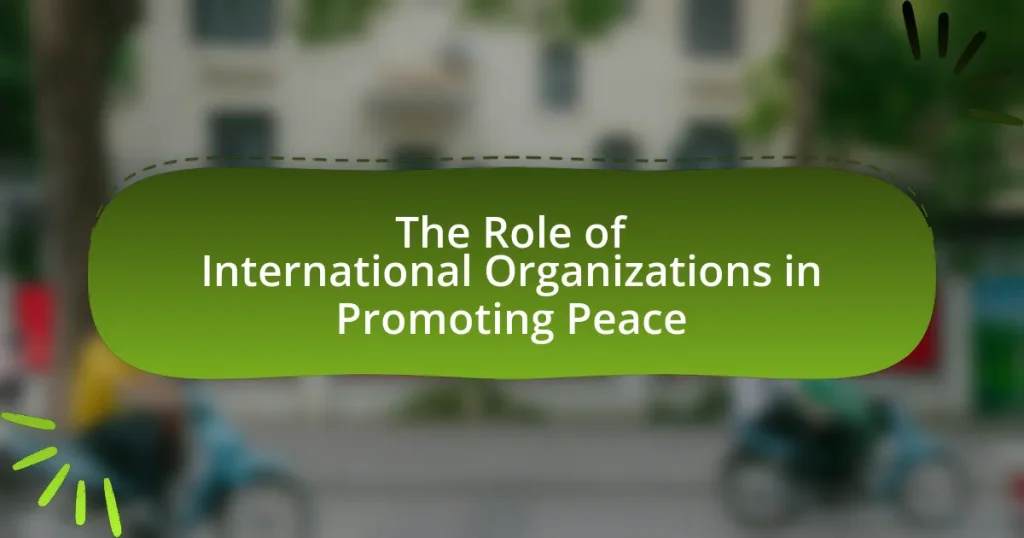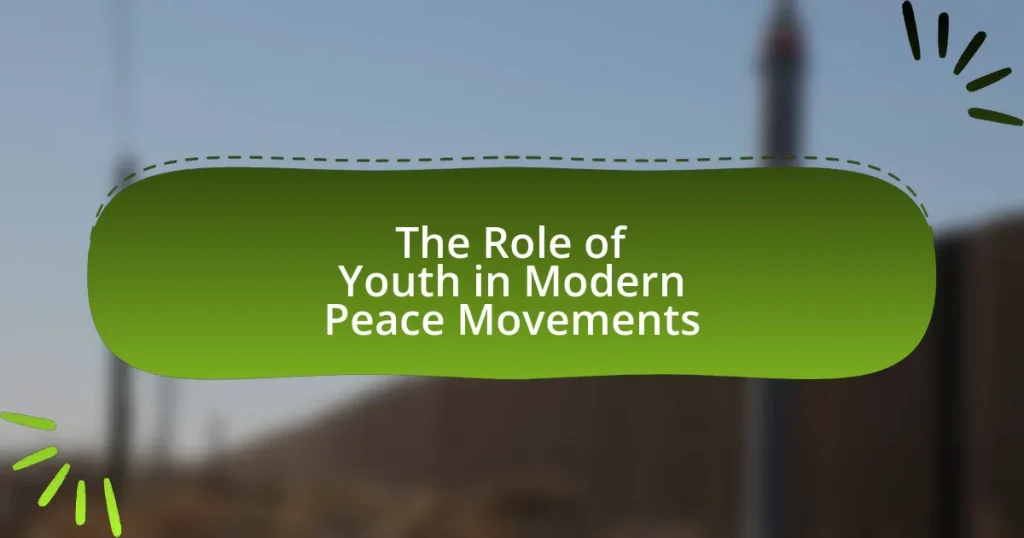The article examines the relationship between environmental activism and anti-war efforts, highlighting their interconnectedness through shared goals of peace and sustainability. It discusses how militarization contributes to ecological destruction and social injustice, with historical events like the Vietnam War serving as pivotal moments that linked these movements. The article also explores the collaboration between activists from both spheres, the impact of military conflicts on environmental degradation, and the motivations driving individuals to engage in these causes. Additionally, it addresses how grassroots campaigns and social media play a crucial role in shaping public opinion and influencing policy related to both environmental and anti-war initiatives.
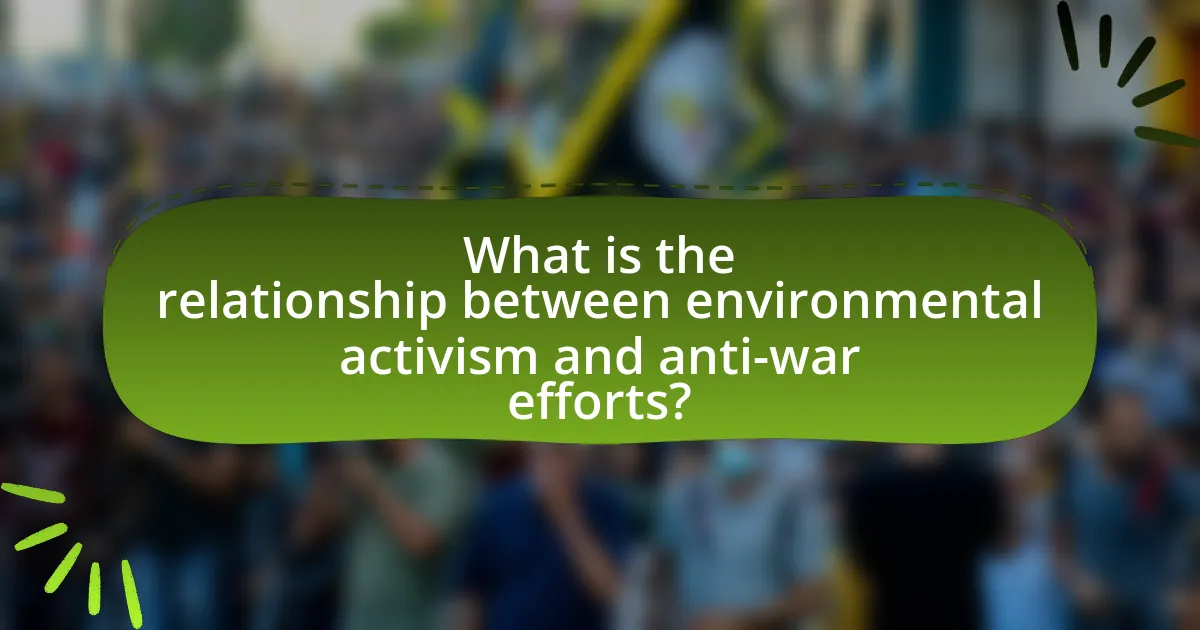
What is the relationship between environmental activism and anti-war efforts?
Environmental activism and anti-war efforts are interconnected through their shared focus on promoting peace and sustainability. Both movements advocate for the protection of human life and the environment, recognizing that militarization and warfare often lead to ecological destruction and social injustice. For instance, the Vietnam War sparked significant environmental degradation, which galvanized activists to link environmental issues with anti-war sentiments, leading to the emergence of the environmental movement in the 1970s. This relationship is further evidenced by organizations like Greenpeace, which have historically opposed military actions that threaten ecological balance, emphasizing that a peaceful world is essential for a sustainable future.
How do environmental activism and anti-war movements intersect?
Environmental activism and anti-war movements intersect primarily through their shared focus on the impacts of militarization on ecological systems. Both movements advocate for the protection of human life and the environment, highlighting how military activities contribute to environmental degradation, such as pollution, habitat destruction, and climate change. For instance, the U.S. military is one of the largest consumers of fossil fuels and a significant contributor to greenhouse gas emissions, which activists argue exacerbates climate change and threatens global ecosystems. This intersection is evident in campaigns that link the consequences of war, such as deforestation and water contamination, to broader environmental justice issues, emphasizing that peace and ecological sustainability are interconnected goals.
What historical events highlight the connection between these two movements?
The Vietnam War protests in the 1960s and 1970s significantly highlight the connection between environmental activism and anti-war efforts. Activists opposed the war not only for its human cost but also for its environmental destruction, such as the use of Agent Orange, which devastated ecosystems in Vietnam. The first Earth Day in 1970 emerged from this context, as many anti-war activists recognized the need to address environmental issues alongside their opposition to military actions. This intersection of movements was further exemplified by the formation of groups like the Environmental Defense Fund, which sought to combat pollution and advocate for environmental justice, often linking these goals to broader social justice and peace initiatives.
How do activists from both movements collaborate on common goals?
Activists from both environmental and anti-war movements collaborate on common goals by uniting around shared values such as social justice, sustainability, and peace. This collaboration often manifests through joint campaigns, where both groups advocate for policies that address the environmental impacts of militarization, such as pollution and resource depletion caused by military activities. For instance, organizations like Greenpeace and Veterans for Peace have worked together to highlight the ecological consequences of war, demonstrating that military conflicts exacerbate climate change and environmental degradation. This partnership is further supported by research indicating that environmental degradation can lead to conflict, thus reinforcing the need for a unified approach to promote peace and environmental stewardship.
Why is the relationship between environmental issues and war significant?
The relationship between environmental issues and war is significant because environmental degradation can exacerbate resource scarcity, leading to conflict. For instance, the United Nations Environment Programme reported that competition over dwindling resources, such as water and arable land, has been a contributing factor in conflicts like the Darfur crisis. Additionally, environmental destruction during warfare, such as deforestation and pollution, can have long-lasting impacts on communities, further destabilizing regions and perpetuating cycles of violence. This interconnection highlights the need for integrating environmental considerations into peacebuilding efforts to mitigate conflict risks.
What environmental consequences arise from military conflicts?
Military conflicts lead to significant environmental consequences, including habitat destruction, pollution, and resource depletion. The use of explosives and weaponry devastates ecosystems, resulting in loss of biodiversity. For instance, the Gulf War in 1991 caused extensive oil spills, releasing approximately 11 million barrels of oil into the Persian Gulf, severely impacting marine life and coastal habitats. Additionally, military activities often result in soil degradation and contamination from hazardous materials, which can persist long after conflicts end. The destruction of infrastructure can also disrupt local water supplies, leading to further environmental and humanitarian crises.
How does war impact environmental activism efforts?
War significantly undermines environmental activism efforts by diverting resources and attention away from ecological issues. During conflicts, governments often prioritize military spending over environmental protection, leading to increased pollution and habitat destruction. For instance, the U.S. military’s operations in Iraq and Afghanistan resulted in substantial environmental degradation, including oil spills and deforestation, which detracted from ongoing environmental initiatives. Additionally, war creates instability that hampers grassroots activism, as communities focus on immediate survival rather than long-term ecological concerns. This pattern has been observed in various conflict zones, where environmental organizations struggle to operate effectively amidst violence and chaos.
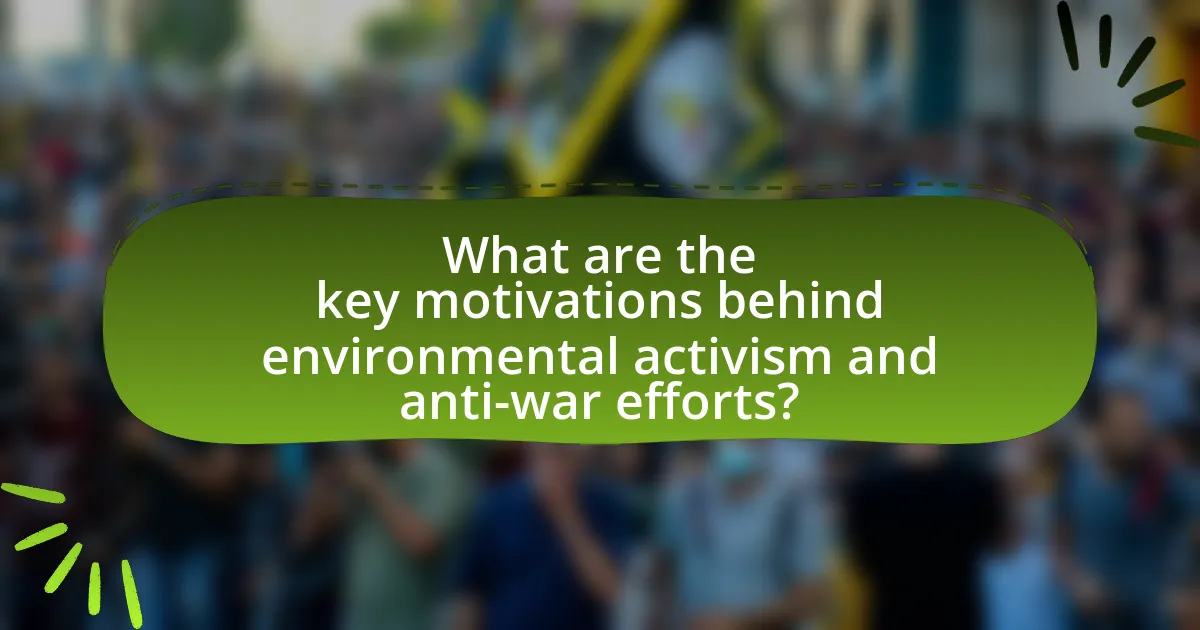
What are the key motivations behind environmental activism and anti-war efforts?
The key motivations behind environmental activism and anti-war efforts include the desire to protect human health, preserve ecosystems, and promote peace. Environmental activists often argue that war exacerbates environmental degradation, leading to pollution, habitat destruction, and climate change. For instance, the U.S. military’s operations have been linked to significant carbon emissions and ecological damage, highlighting the intersection of these issues. Additionally, anti-war movements frequently emphasize the social and economic costs of conflict, advocating for resource allocation towards sustainable practices rather than military expenditures. This connection is evident in campaigns that unite both movements, such as those advocating for a Green New Deal, which seeks to address climate change while promoting social justice and peace.
What drives individuals to engage in environmental activism?
Individuals engage in environmental activism primarily due to a strong sense of responsibility towards the planet and a desire to combat climate change. This motivation is often fueled by awareness of environmental degradation, such as rising global temperatures, deforestation, and pollution, which are supported by scientific consensus indicating that human activities significantly contribute to these issues. For instance, the Intergovernmental Panel on Climate Change (IPCC) reports that human-induced greenhouse gas emissions have led to a 1.1°C increase in global temperatures since the late 19th century, prompting many to take action to mitigate these effects. Additionally, personal values, community influence, and the desire for social justice further drive individuals to participate in activism, as they seek to protect vulnerable populations disproportionately affected by environmental issues.
How do personal values influence participation in environmental movements?
Personal values significantly influence participation in environmental movements by shaping individuals’ beliefs about the importance of environmental protection and social responsibility. For instance, individuals who prioritize sustainability and ecological integrity are more likely to engage in activism, as their values align with the goals of environmental movements. Research indicates that people with strong environmental values are more inclined to participate in activities such as protests, community clean-ups, and advocacy campaigns. A study published in the journal “Environmental Politics” by authors Dunlap and Jones (2002) found that personal values related to environmentalism directly correlate with higher levels of activism, demonstrating that those who view environmental issues as a moral obligation are more likely to take action.
What role does education play in motivating activists?
Education plays a crucial role in motivating activists by providing them with the knowledge and skills necessary to understand complex social issues and advocate for change. Through education, individuals gain awareness of environmental and social injustices, which can ignite a passion for activism. For instance, studies show that individuals with higher levels of education are more likely to engage in civic activities, including protests and advocacy campaigns. Research conducted by the Pew Research Center indicates that educated individuals are more likely to recognize the importance of environmental issues and participate in movements aimed at addressing them. This connection between education and activism underscores the transformative power of knowledge in fostering a commitment to social and environmental causes.
What motivates individuals to participate in anti-war efforts?
Individuals participate in anti-war efforts primarily due to a combination of moral beliefs, personal experiences, and the desire for social justice. Many are motivated by a strong ethical stance against violence and the belief that war leads to unnecessary suffering and destruction. For instance, historical movements, such as the Vietnam War protests, showcased how personal experiences, like witnessing the impact of war on communities, can galvanize individuals into action. Additionally, the interconnectedness of social issues, including environmental degradation caused by military activities, further drives participation, as activists recognize that war exacerbates ecological crises. This understanding is supported by research indicating that individuals who are engaged in environmental activism often extend their advocacy to anti-war efforts, seeing both as part of a broader struggle for peace and sustainability.
How do personal experiences shape anti-war activism?
Personal experiences significantly shape anti-war activism by influencing individuals’ perceptions of conflict and its consequences. For instance, veterans who have witnessed the horrors of war often become vocal advocates against military interventions, drawing from their firsthand experiences to highlight the human cost of conflict. Research indicates that personal narratives, such as those shared by survivors of war or families affected by military actions, can evoke empathy and mobilize communities toward anti-war efforts. A study published in the Journal of Peace Research found that personal testimonies can increase public awareness and support for anti-war movements, demonstrating the powerful impact of individual experiences on collective activism.
What societal factors contribute to the rise of anti-war movements?
Societal factors contributing to the rise of anti-war movements include widespread public discontent with government policies, economic hardship, and increased access to information through media. Public discontent often arises from perceived injustices or failures in foreign policy, leading citizens to mobilize against military actions. Economic hardship, such as recessions or high unemployment rates, can amplify anti-war sentiments as individuals prioritize domestic stability over foreign conflicts. Additionally, the rise of digital media has facilitated the rapid dissemination of information, allowing grassroots organizations to organize and communicate effectively, as seen during the Vietnam War protests in the 1960s and 1970s, where media coverage played a crucial role in shaping public opinion against the war.
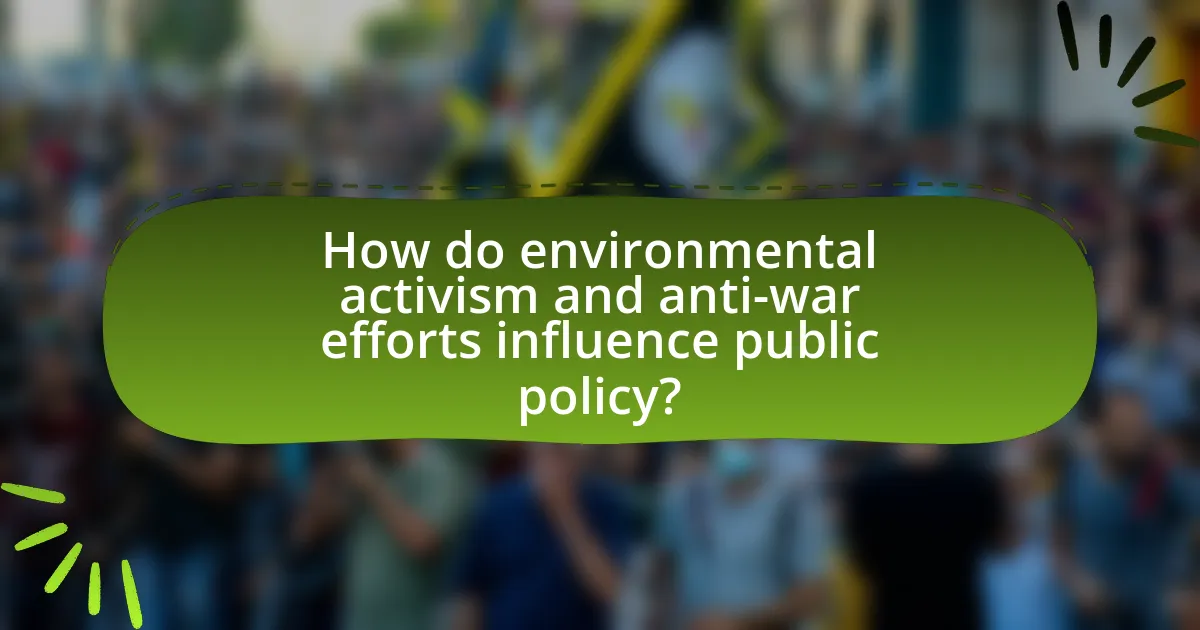
How do environmental activism and anti-war efforts influence public policy?
Environmental activism and anti-war efforts significantly influence public policy by mobilizing public opinion and pressuring lawmakers to enact change. For instance, the environmental movement has led to the establishment of policies like the Clean Air Act and the Clean Water Act in the United States, driven by widespread public support for environmental protection. Similarly, anti-war movements, such as those during the Vietnam War, resulted in policy shifts, including the War Powers Act of 1973, which aimed to limit presidential power in military engagements. These movements utilize protests, advocacy campaigns, and grassroots organizing to raise awareness and create a sense of urgency, compelling policymakers to respond to the demands of their constituents.
What impact do these movements have on legislation?
Environmental activism and anti-war efforts significantly influence legislation by shaping public opinion and prompting lawmakers to address related issues. For instance, the environmental movement has led to the enactment of laws such as the Clean Air Act and the Clean Water Act in the United States, which were driven by public demand for environmental protection. Similarly, anti-war movements have resulted in legislative changes, such as the War Powers Act of 1973, which aimed to limit the president’s ability to engage in military actions without congressional approval. These movements mobilize citizens, create awareness, and apply pressure on legislators, ultimately leading to the introduction and passage of laws that reflect the values and concerns of the public.
How do activists lobby for environmental and anti-war policies?
Activists lobby for environmental and anti-war policies by organizing campaigns, engaging in grassroots mobilization, and influencing policymakers through direct advocacy. They utilize strategies such as public demonstrations, petitions, and coalition-building to raise awareness and pressure government officials. For instance, organizations like Greenpeace and the Sierra Club have historically combined environmental advocacy with anti-war efforts, highlighting the connections between militarism and environmental degradation. Research indicates that military activities contribute significantly to carbon emissions, prompting activists to argue for policies that address both environmental sustainability and peace.
What successful policies have emerged from these movements?
Successful policies that have emerged from the intersection of environmental activism and anti-war efforts include the establishment of the National Environmental Policy Act (NEPA) in 1969, which mandates environmental assessments for federal projects, and the promotion of renewable energy initiatives aimed at reducing dependence on fossil fuels often linked to military conflicts. NEPA was a direct response to growing public concern about environmental degradation and the impacts of war on natural resources, reflecting the influence of grassroots movements advocating for both peace and environmental protection. Additionally, policies promoting sustainable development and climate action, such as the Paris Agreement, have been shaped by the advocacy of these interconnected movements, emphasizing the need for global cooperation to address both environmental and social justice issues.
How do grassroots campaigns in both movements shape public opinion?
Grassroots campaigns in both environmental activism and anti-war efforts significantly shape public opinion by mobilizing community engagement and fostering collective action. These campaigns utilize local networks to raise awareness about issues, effectively translating complex topics into relatable narratives that resonate with the public. For instance, the anti-war movement during the Vietnam War saw grassroots organizations like Students for a Democratic Society (SDS) galvanizing protests that influenced public sentiment against the war, leading to a shift in national discourse. Similarly, environmental movements, such as the Earth Day initiative, have successfully engaged millions in advocacy, resulting in increased public support for environmental policies and legislation. Research indicates that grassroots efforts can lead to a 20% increase in public awareness and support for specific causes, demonstrating their effectiveness in shaping opinions and driving social change.
What strategies do activists use to raise awareness about their causes?
Activists use various strategies to raise awareness about their causes, including social media campaigns, public demonstrations, and educational outreach. Social media campaigns leverage platforms like Twitter and Instagram to disseminate information rapidly, engage audiences, and mobilize support; for instance, the #FridaysForFuture movement effectively utilized social media to promote climate strikes globally. Public demonstrations, such as marches and rallies, visually represent the urgency of issues, drawing media attention and public interest, as seen in the Women’s March in 2017, which attracted millions worldwide. Educational outreach involves workshops, seminars, and collaborations with schools to inform communities about specific issues, exemplified by organizations like Greenpeace, which conducts educational programs on environmental conservation. These strategies collectively enhance visibility and foster community engagement around activist causes.
How effective are social media campaigns in promoting these movements?
Social media campaigns are highly effective in promoting environmental activism and anti-war efforts. These platforms enable rapid dissemination of information, mobilization of supporters, and engagement with a global audience. For instance, the #FridaysForFuture movement, initiated by Greta Thunberg, gained international attention and participation through social media, leading to millions of young people participating in climate strikes worldwide. Additionally, research by the Pew Research Center indicates that 69% of adults in the U.S. use social media, making it a powerful tool for raising awareness and fostering community around these movements. The ability to share personal stories, organize events, and create viral content significantly enhances the visibility and impact of both environmental and anti-war campaigns.
What are some practical ways to support the relationship between environmental activism and anti-war efforts?
Practical ways to support the relationship between environmental activism and anti-war efforts include promoting joint campaigns that highlight the environmental impacts of militarization, advocating for policies that redirect military funding towards sustainable development, and fostering collaborations between environmental organizations and peace groups. For instance, studies show that military activities contribute significantly to carbon emissions, with the U.S. Department of Defense being one of the largest institutional greenhouse gas emitters. By raising awareness of this connection, activists can mobilize public support for initiatives that address both environmental degradation and the consequences of war. Additionally, organizing events that combine environmental education with anti-war messaging can strengthen community ties and amplify the voices of both movements.
How can individuals get involved in local initiatives that combine both causes?
Individuals can get involved in local initiatives that combine environmental activism and anti-war efforts by participating in community organizations that focus on both issues. Many local groups advocate for peace while promoting sustainable practices, such as reducing military spending to fund environmental programs. For example, organizations like Veterans for Peace actively campaign against militarism and advocate for environmental justice, demonstrating the interconnectedness of these causes. Engaging in local events, volunteering for campaigns, and attending meetings can help individuals contribute to these initiatives effectively.
What resources are available for those looking to educate themselves on these issues?
Books, documentaries, and online courses are valuable resources for educating oneself on the relationship between environmental activism and anti-war efforts. Notable books include “This Changes Everything: Capitalism vs. The Climate” by Naomi Klein, which explores the intersection of environmental issues and social justice, and “The Ecology of War: Environmental Destruction in the 21st Century” by David P. Barash, which discusses the environmental impacts of conflict. Documentaries such as “Before the Flood” and “The True Cost” provide visual insights into these interconnected issues. Online platforms like Coursera and edX offer courses on environmental science and peace studies, allowing learners to engage with expert content. These resources collectively provide a comprehensive understanding of how environmental activism and anti-war movements influence each other.
